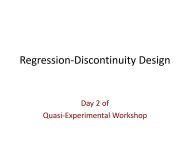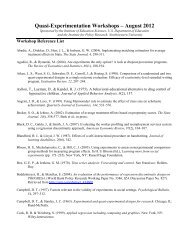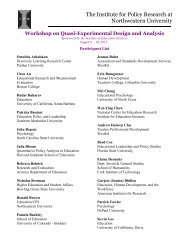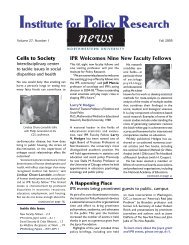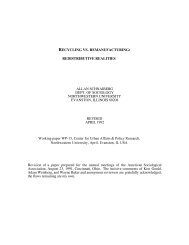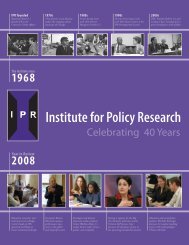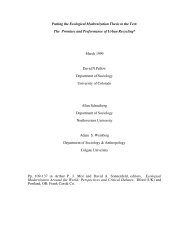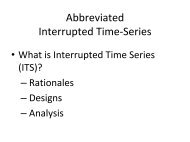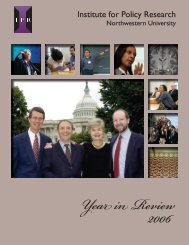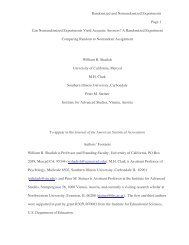Download working paper PDF - Institute for Policy Research ...
Download working paper PDF - Institute for Policy Research ...
Download working paper PDF - Institute for Policy Research ...
Create successful ePaper yourself
Turn your PDF publications into a flip-book with our unique Google optimized e-Paper software.
<strong>for</strong> adult non-elderly plaintiffs is $100,000 v. $127,000 <strong>for</strong> elderly plaintiffs. 38<br />
awards show a similar pattern.<br />
Median<br />
Panel B. Paid Damage in Tried Cases: Amounts<br />
Damages type Economic damages Non-econ + punitive damages<br />
Age group Mean Median Mean Median<br />
Adult Non-elderly 245 50 100 63<br />
Elderly 70 36 127 119<br />
Elderly/Adult Non-Elderly 28.5% 72.9% 127% 188%<br />
Mean and median amounts of paid economic damages and paid (non-economic + punitive damages), <strong>for</strong> 294<br />
nonduplicate, non-nursing home, med mal cases involving adult plaintiffs with plaintiff verdicts, closed from<br />
1988-2007 with payout > $25,000 in 1988 dollars. Amounts in thousands of 1988 dollars.<br />
Thus, the lower mean payouts to elderly plaintiffs are partly explained by lower<br />
economic damages. To be sure, this is not the whole story. It is plausible, indeed likely,<br />
that attorneys will only accept cases with low economic damages if expected (noneconomic<br />
+ punitive damages) are relatively high. The evidence in Panel B is consistent<br />
with this selection effect.<br />
E. Blockbuster Payouts<br />
Med mal payouts have a strong positive skew – a limited number of large payouts<br />
account <strong>for</strong> a significant fraction of the total dollars paid by defendants and their insurers.<br />
We saw in Figure 4 that mean payouts are substantially lower <strong>for</strong> elderly than <strong>for</strong> nonelderly<br />
plaintiffs. In contrast the differences in median payouts to the two groups are<br />
smaller, although both differences largely disappear over our sample period. This pattern<br />
suggests that over the full sample period, the elderly are less likely to receive very large<br />
payouts. We confirm this by examining the largest (“blockbuster”) payouts in our dataset.<br />
As Figure 4 reflects, the top 100 (200) claims are only 0.7% (1.4%) of total claims, but<br />
account <strong>for</strong> 14.5% (21.7%) of total payouts. 39<br />
As Figure 4 shows, although the elderly account <strong>for</strong> 16% of all claims (see Table<br />
2), they account <strong>for</strong> only 1% of the largest 100 or 200 claims (one of the top 100; two of<br />
the top 200). Both of these payouts were in death cases, which likely had small economic<br />
damages (we cannot be sure because both cases settled be<strong>for</strong>e trial). Both preceded the<br />
2003 non-econ cap. If the non-econ cap had applied during our entire sample period, it is<br />
possible that none of the top 200 payouts would have gone to an elderly claimant.<br />
38 There are only 12 post-cap trials in our dataset, of which 2 involve elderly plaintiffs. This is too few<br />
<strong>for</strong> us to directly assess how the non-econ cap affects allowed awards and payouts in tried cases.<br />
39 The top 100 claims account <strong>for</strong> $637M in payouts, and the top 200 claims account <strong>for</strong> $954M.<br />
16



